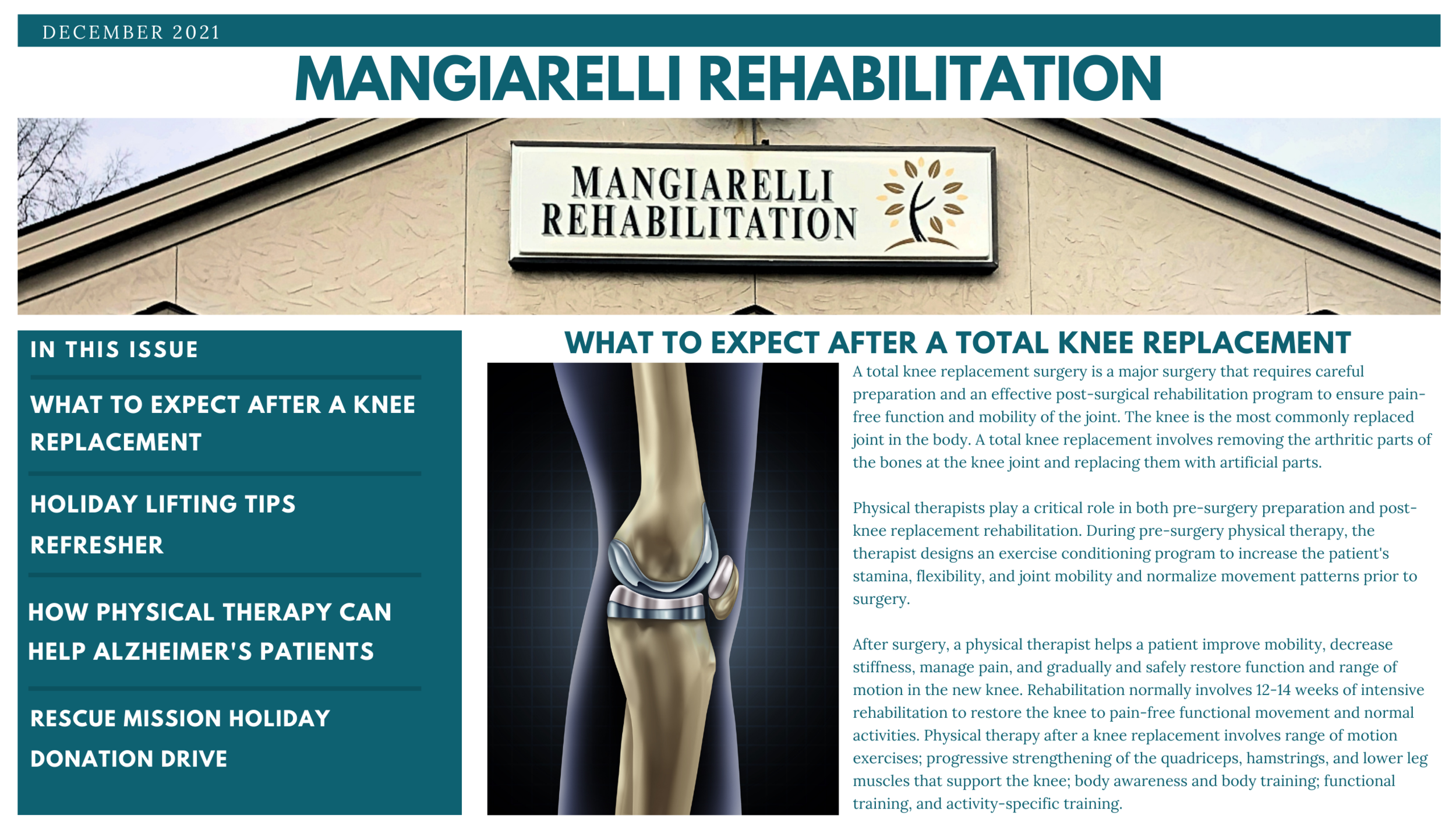Mangiarelli Rehabilitation Physical Therapy Blog
Walking After A Total Hip Replacement and Femoral Nerve Palsy
After undergoing a total hip replacement and suffering from femoral nerve palsy, Mangiarelli Rehabilitation physical therapy patient Kay has made incredible progress, advancing from walking with a brace with a walker to now walking with a cane! Femoral nerve palsy post-hip replacement involves injury to or compression of the femoral nerve, one of the largest nerves in the leg. A physical therapist can help reduce compression on the femoral nerve and help patients safely regain quadriceps muscle strength, relieve nerve pain, and improve walking ability.
The Role of Nutrition after Joint Replacement Surgery
Joint replacement surgery is a complex surgery that places significant stress on your body and increases your nutritional needs as you heal and recover. Adequate nutrition during recovery from surgery can help to control inflammation, provide the necessary nutrients to rebuild and restore injured tissue, decrease the risk of muscle atrophy, and preserve muscle strength. Eating a high-quality, fiber and antioxidant-rich, anti-inflammatory diet post-surgery can play a pivotal role in your body’s healing process and recovery. Check out our tips for the top nutrients to consume post-joint replacement surgery!
The Importance of Prehabilitation Before Surgery
Prehabilitation has numerous benefits for pre-surgery patients. Prehabilitation is an individualized exercise conditioning program that prepares the body for the stresses of surgery, manages symptoms, and helps restore function in the injured area as much as possible prior to surgery. Prehabilitation, or “prehab,” works on improving a patient’s movement, flexibility, and strength before surgery to set them up for a successful recovery after surgery. Prehab has been shown to shorten recovery time and a patient’s hospital stay, reduce post-surgical pain and inflammation, and increase strength, stamina, and mobility.
Physical Therapy for Shoulder Osteoarthritis
Shoulder osteoarthritis occurs when the cartilage that lines the shoulder joint is worn or torn away, causing pain, swelling, and reduced function in the shoulder. Shoulder osteoarthritis most commonly affects those over age 50, particularly older women. Physical therapy can help those with shoulder osteoarthritis manage and decrease pain, prevent progression of the disease, and restore movement and function in the shoulder. If the osteoarthritis is severe, surgery may be recommended to restore function followed by intensive rehabilitative care.
What To Expect After a Total Shoulder Replacement
Total shoulder replacement surgery involves removing the damaged ball and socket of the shoulder joint and replacing it with a functional metal joint to eliminate pain and restore function to the shoulder. Nearly 70,000 Americans undergo shoulder replacement surgery each year. Physical therapy after a total shoulder replacement is critical to regaining full function, strength, mobility, and range of motion in the shoulder joint. The physical therapist not only helps the patient manage pain and swelling post-surgery but also guides the patient through a progressive shoulder and scapular strengthening program for optimal recovery.
What to Expect After a Total Hip Replacement
A total hip replacement surgery is a common orthopedic surgery performed due to arthritis or certain hip fractures to relieve severe pain, improve hip mobility, and restore function. A hip replacement involves removing damaged bone and cartilage from the hip joint and replacing it with prosthetic parts. Physical therapists play an important role in pre-surgery preparation and post-hip replacement rehabilitation, helping to improve mobility, manage pain, regain strength, and restore function in your new hip.
December 2021 Newsletter
Our December 2021 Newsletter highlights what to expect after a knee replacement, holiday lifting tips refresher, how physical therapy can help Alzheimer’s patients, and how to participate in the rescue mission holiday donation drive.
What To Expect After a Total Knee Replacement
Are you unsure what to expect after total knee replacement surgery? Check out our blog to learn what to expect throughout the rehabilitation process post-knee replacement! Total knee replacement surgery is a major surgery that requires careful preparation and an effective post-surgical rehabilitation program to ensure pain-free function and mobility of the joint. Physical therapists play a critical role in pre-surgery preparation and post-knee replacement rehabilitation, helping you improve mobility, decrease stiffness, manage pain, and gradually and safely restore function and range of motion in your new knee.
March 2021 Newsletter
Check out our March 2021 Newsletter with updates on total joint replacement rehabilitation, treatment for wrist and hand injuries, how to improve your ankle mobility with physical therapist Bobby, and celebrating #NationalNurtritionMonth.
Total Joint Replacement Rehabilitation
Total joint replacement surgery is a major surgery requiring careful preparation and an effective post-surgical rehabilitation program to ensure pain-free function and mobility of the joint. Total joint replacement surgery removed the entirety of the damaged joint, replacing it with artificial parts to maintain joint function. Physical therapy plays a critical role in successful rehabilitation of the new joint and restoring movement, strength, flexibility, and range of motion to the joint for a timely return to daily activities, work, and sport.





















